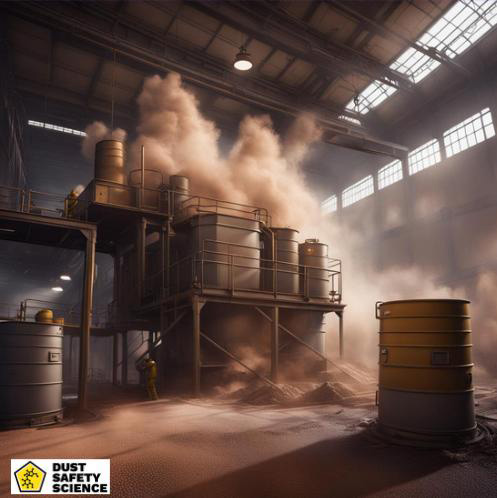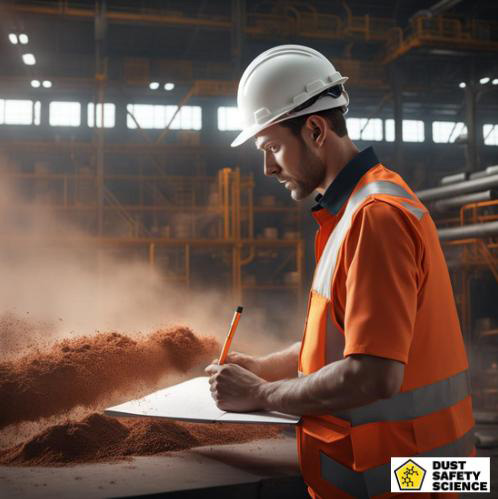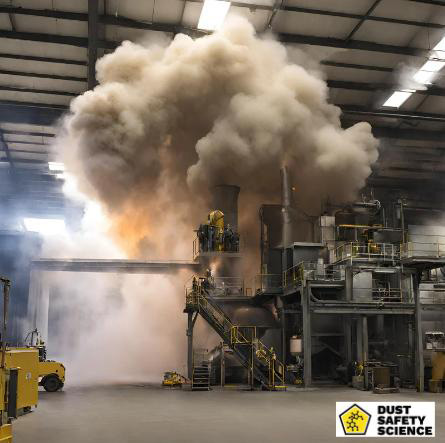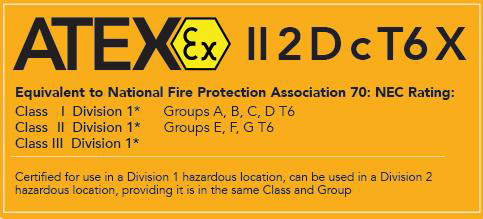Updated October 28, 2024 Authored by Dr. Chris Cloney and Jon Barrett

Key Takeaways:
- Effective Dust Control: Learn how to implement robust combustible dust containment solutions to enhance workplace safety and prevent hazardous incidents.
- Dust Management Techniques: Explore a variety of strategies and methods for the collection and cleaning of combustible dust, safeguarding your facility from potential ignition sources..
- Compliance and Best Practices: Stay up-to-date with industry compliance requirements and discover best practices to maintain a dust-free environment, promoting a secure and efficient workspace.
Table of Contents:
- What is a Combustible Dust Explosion?
- What is Fugitive Combustible Dust Accumulation
- How to Develop a Combustible Dust Control Management Plan
- Different Types of Combustible Dust Collection Systems
- Designing Your Combustible Dust Collection System
- Correct Design of Combustible Dust Collection Hoods
- Different Types of Combustible Dust Cleaning Procedures
- Dry and Wet Combustible Dust Collection Systems
- Explosion Proof and ATEX rated Vacuum Systems, for Combustible Dust
- Conclusion
What are Combustible Dust Explosions?
Combustible dust explosions can be a catastrophic event, and understanding their fundamentals is paramount to workplace safety. Such explosions occur when fine particles of combustible materials, often invisible in the air, ignite in a confined space. To prevent these disasters, effective dust containment, collection, and cleaning practices are essential. A dust hazard analysis is imperative to prevent dust explosions.
Combustible dust, when suspended in the atmosphere and ignited, can lead to a rapid release of energy, resulting in devastating explosions. Our comprehensive guide will walk you through the intricacies of combustible dust explosion prevention, highlighting the importance of proactive measures in safeguarding lives and assets.

What is Fugitive Combustible Dust Accumulation
Fugitive combustible dust accumulation refers to the presence of fine particulate materials within an industrial or commercial setting that can ignite and result in hazardous explosions or fires. These dust particles, often produced during manufacturing or processing operations, can accumulate in hidden or hard-to-reach areas such as rafters, ventilation systems, and equipment surfaces. When left unaddressed, fugitive dust poses a significant risk to the safety of workers and the facility.
To mitigate the dangers of fugitive combustible dust, it is crucial to adopt proper housekeeping practices and establish a comprehensive dust management program. This includes regular cleaning, inspection, and maintenance procedures, as well as the installation of dust collection systems, to reduce the potential for dust to become suspended in the air. Employers must also provide adequate training for their staff to recognize and handle fugitive dust hazards. Safety protocols need to be enforced to minimize the risk of ignition sources, such as sparks or hot surfaces, coming into contact with the accumulated dust. Any fire needs three elements. These elements are known as the fire triangle, 1. Fuel to burn 2. Oxygen 3. Ignition source (heat, spark, etc. ).
In summary, fugitive combustible dust accumulation is a critical safety concern in various industries, as it can lead to catastrophic incidents if not properly managed. Effective preventive measures and stringent safety practices, including a dust hazard analysis, are essential for ensuring workplace safety and reducing the potential for dust-related accidents.

How to Develop a Combustible Dust Control Plan
A robust combustible dust control management plan is essential for industries where fine particulate materials pose explosion and fire risks. This dust hazard analysis plan outlines proactive measures to prevent the accumulation of combustible dust and mitigate potential hazards, including identifying issues with industrial dust collection systems. Key steps in developing a comprehensive dust control management plan, to prevent a dust explosion include:
Identifying Hazards: Start by identifying the sources of combustible dust in your facility. This includes understanding the materials, processes, and equipment that generate dust.
Risk Assessment: Evaluate the severity of potential dust-related hazards, considering factors like dust concentration, ignition sources, and process conditions. This assessment informs the level of control measures needed to prevent a dust explosion.
Housekeeping and Inspection: Implement regular housekeeping practices to minimize dust accumulation. Inspect areas where dust can collect, such as rafters, ducts, and equipment, and clean them as necessary.
Dust Collection Systems: Install appropriate industrial dust collection systems, like industrial vacuum cleaners, cyclone separators, or baghouses, to capture and contain dust at the source.
Preventive Maintenance: Establish maintenance routines to ensure the proper functioning of equipment, including dust collectors and ventilation systems, to prevent dust from escaping into the environment, and to prevent a dust explosion.
Ignition Source Control: Identify potential ignition sources, such as hot surfaces or electrical equipment, and implement safety measures to minimize the risk of sparks or flames coming into contact with combustible dust.
Training and Education: Train employees on the hazards of combustible dust and the proper use of control measures, to prevent a dust explosion. Create a culture of safety awareness within the organization.
Emergency Response Plan: Develop a clear emergency response plan to address dust-related incidents, including procedures for evacuations, fire suppression, and medical assistance.
Documentation and Records: Maintain records of dust control activities, inspections, and training, ensuring compliance with relevant regulations.
Regulatory Compliance: Stay informed about local, state, and federal regulations related to combustible dust and ensure your plan aligns with these requirements.

Types of Combustible Dust Collection Systems
Combustible dust poses a significant safety hazard in various industrial settings, making the selection of appropriate industrial dust collection systems crucial. Different industrial combustible dust collection systems are designed to capture and contain particles to prevent potential explosions or fires. Here, we discuss various dust collection systems and their key characteristics:
Cyclone Separators: Cyclone separators use centrifugal force to separate dust from the air stream. These systems are effective in capturing larger particles and can pre-separate materials before more advanced filtration methods. Cyclone separators are commonly used in initial stages of dust collection.
Baghouses: Baghouses are equipped with fabric filter bags that capture dust as air passes through them. They are efficient in capturing fine particles and can handle high air volumes. Baghouses are suitable for a wide range of applications and industries.
Cartridge Collectors: Cartridge dust collectors use cylindrical filter cartridges to trap particles. Cartridge dust collectors are versatile, efficient, and compact, making them suitable for facilities with limited space. Cartridge dust collectors are known for their ease of maintenance and filter replacement.
Wet Dust Collectors: These systems use water or other liquid to capture and suppress dust, and are also called wet scrubbers. Wet dust collectors or wet scrubbers are particularly effective for handling dust as they can eliminate the risk of ignition. Wet dust collectors or wet scrubbers are commonly used in industries dealing with explosive materials. However, it is important to keep in mind that some metals may also react with liquids or gases and evaluate this in your Dust Hazard Analysis.
Electrostatic Precipitators: Electrostatic precipitators use an electrostatic charge to attract and collect dust particles on charged plates or wires. They are effective for removing fine particles, and they require less frequent filter replacement. However, they can be complex to operate and maintain.
Ventilation and Dilution: This method involves diluting the dust-laden air with clean air and exhausting it outdoors. While not a collection system per se, it can be a practical approach for reducing dust concentration in the workplace.
Combustible dust collectors and industrial dust collection systems, have advantages and limitations, and the choice depends on factors such as the type of dust generated, process requirements, available space, and regulatory compliance. Industries must assess their specific needs and consult with experts to select the most suitable industrial dust collection systems and dust collectors to enhance safety and prevent a dust explosion.
Designing A Combustible Dust Collection System
Designing robust industrial combustible dust collection systems is essential for industries where fine particulate materials pose explosion and fire hazards. A well-designed dust collector system efficiently captures and contains dust to ensure a safe working environment, and to prevent a dust cloud. Here are key considerations for designing effective combustible dust collectors
Dust Hazard Assessment: Begin with a comprehensive dust hazard assessment to understand the types of dust produced, its explosive characteristics, and potential ignition sources. This assessment informs the overall dust collector system design, to prevent a dust explosion.
Source Capture: Implement source capture methods to capture dust at its point of origin. This minimizes dust dispersion and enhances dust collector efficiency.
Airflow and Ductwork: Determine the required airflow to capture and transport dust to the collection equipment. Proper ductwork design ensures efficient dust transportation without clogs or dust settling.
Dust Collection Equipment: Select the appropriate dust collector equipment (e.g., cyclone separators, baghouses, cartridge collectors) based on the dust properties and the required filtration efficiency. Ensure that the equipment complies with safety and regulatory standards.
Explosion Protection: In facilities with potentially explosive dust, incorporate explosion protection measures such as venting, suppression, or isolation to prevent catastrophic dust-related incidents.
System Location: Place dust collection equipment strategically to minimize the length of ductwork and reduce energy consumption. Consider the ease of maintenance and access for filter replacement.
Regular Maintenance: Develop a maintenance plan to ensure the proper functioning of the dust collector system. Regular inspections, filter replacement, and equipment upkeep are crucial to maintain collection efficiency, and to prevent a dust explosion.
Safety Measures: Integrate safety features, such as spark detection and extinguishing systems, to prevent ignition sources from causing fires or explosions.
Operator Training: Train personnel on the safe operation of the dust collector system, including recognizing warning signs, maintaining equipment, and responding to dust-related incidents.
Documentation and Compliance: Maintain records of dust collector system design, safety measures, and compliance with relevant regulations. Regularly review and update the industrial dust collector systems as needed, to prevent a dust explosion.
Emergency Response: Develop clear emergency response procedures in case of dust-related incidents, from the dust collector system, including evacuation plans, fire suppression methods, and medical assistance.

Designing of Combustible Dust Collection Hoods
Properly designed combustible dust collection hoods play a crucial role in the safe and efficient control of fine particulate materials that pose explosion and fire hazards in industrial settings. This summary discusses the importance of correct design and explosion protection when it comes to combustible dust collection hoods and outlines key considerations for their effective dust collector implementation, to prevent a dust explosion.
Hood Selection: The first step in designing an effective dust collection hood is choosing the right type for the specific application. Consider factors such as which type of materials produce dust, the dust source, airflow patterns, and the size and shape of the hood opening.
Capture Velocity: Establish an appropriate capture velocity, the speed at which air is drawn into the hood, to effectively capture and control the released dust. This velocity should be sufficient to overcome any upward air currents and direct the dust into the collection system.
Hood Placement: Position hoods as close as possible to the dust source, ensuring that they encompass the entire area where dust is generated. Proper placement minimizes the chance of dust escaping the collection zone, and operating similarly to HEPA dust extractors.
Ductwork Design: Develop a well-planned ductwork system that efficiently transports dust-laden air from the hood to the dust collection equipment. Consider the velocity and cross-sectional area of the ductwork to avoid dust settling or clogs.
Hood Design for Containment: The design of the hood should focus on containing dust and preventing its escape. This includes selecting appropriate materials and shapes that minimize turbulence and dust buildup within the hood.
Safety Measures: Implement explosion protection safety features in hoods designed for potentially explosive particles, such as explosion venting, suppression, or isolation, to prevent catastrophic incidents.
Regular Maintenance: Establish a maintenance schedule for the hoods, which includes inspections and cleaning. Maintaining the hoods ensures their continued effectiveness and safety.
Operator Training: Train personnel in the proper use and maintenance of the dust collector hoods, emphasizing safety protocols and recognizing warning signs.
Regulatory Compliance: Ensure that the design and operation of the hoods comply with local, state, and federal safety regulations. Regularly review and update the system to maintain compliance.
Documentation: Keep detailed records of the design, safety measures, maintenance activities, and compliance with regulations, which can be invaluable for audits and improvements.
Types of Combustible Dust Cleaning Procedures
Combustible dust poses a significant safety risk in industrial settings, and adopting appropriate cleaning procedures is essential for mitigating this hazard. Different types of combustible dust cleaning procedures are designed to remove and control dust accumulation, reducing the potential for a dust cloud and explosions or fires.
Various cleaning methods and their key characteristics are given below:
Dry Cleaning: This method involves using tools like brooms, brushes, or compressed air to remove loose dust from surfaces. While cost-effective, dry cleaning can sometimes disperse dust into the air, potentially increasing the hazard if not controlled carefully. Cleaning with compressed air in particular has caused devastating explosions in the past and NFPA 652 and other standards have very stringent guidelines on when this type of cleaning is performed.
Wet/Misting/Ultra Low Volume Fogging Cleaning: Wet/Misting/Ultra Low Volume Fogging cleaning employs water or other liquid agents to suppress dust while cleaning. This method can be effective in preventing dust resuspension and is particularly useful in areas with potentially explosive particles.
Vacuum Cleaning: Industrial vacuum cleaners designed for combustible dust removal use specialized filters and containment systems to capture dust. Vacuum cleaning is efficient, especially when equipped with HEPA filters, which can handle fine particles without releasing them back into the environment. All Vacuums must be Explosion-Proof, Anti-Static Vacuum Cleaners, Hoses and Tools, and ATEX Certified for use in National Fire Protection Association (NFPA) 70: NEC rating Class I, Division 1 (Zone 1 only), Groups A,B,C,D T6 and Class II, Division 1, Groups E, F, G T6.
Enclosure Cleaning: For equipment and processes that generate dust, enclosure cleaning systems capture dust at the source. These enclosures can be custom-designed to control dust emissions efficiently.
High-Efficiency Particulate Air (HEPA) Cleaning: HEPA filters are highly efficient at capturing fine particles, including combustible dust. When used in vacuum cleaners or air filtration systems, HEPA technology significantly reduces the risk of dust accumulation and dispersal.
Dust Containment Systems: Install dust containment systems in areas where dust generation is common. These systems can isolate the dust and prevent it from spreading throughout the facility.
Regular Cleaning Schedules: Implementing a proactive and regular cleaning schedule is essential to keep dust accumulation under control. Regular cleaning reduces the risk of dust reaching hazardous levels.
Training and Safety Measures: Properly train workers in cleaning procedures and safety measures to minimize the risk of incidents during the cleaning process. Ensure that workers use appropriate personal protective equipment when dealing with combustible dust.

Dry and Wet Combustible Dust Collection Systems
Combustible dust poses a serious safety risk in various industrial settings, necessitating the use of an effective dust control system. Two primary approaches for controlling combustible dusts are dry and wet collection systems. This summary provides a comparative overview of these systems and their key characteristics.
Dry Combustible Dust Collection Systems:
- Operation: Dry dust collector systems use mechanical means, such as filters or cyclones, to capture and collect dust from the air. They do not involve the use of water or other liquids.
- Effectiveness: Dry dust collector systems are highly efficient at capturing fine dust particles, making them suitable for a wide range of applications. They are particularly effective for non-hygroscopic dust that doesn’t readily absorb moisture.
- Maintenance: They typically require regular maintenance to prevent dust buildup on filters or within the system. Filter replacement and cleaning are crucial to maintaining efficiency.
- Explosion Risk: Dry dust collector systems may pose an explosion risk if not equipped with proper safety measures like explosion venting or suppression.
- Environmental Impact: Dry systems have minimal environmental impact, as they don’t consume water and are often more energy-efficient than wet systems.
Wet Combustible Dust Collection Systems:
- Operation: Wet systems use water or other liquid agents to capture dust. The liquid binds with dust particles, preventing them from becoming airborne.
- Effectiveness: Wet systems are highly effective at dust suppression and are particularly useful in applications where dust is hygroscopic or prone to ignition. They are also effective in controlling volatile organic compounds (VOCs).
- Maintenance: Wet systems require maintenance to prevent clogs and contamination in the liquid. Proper drainage and water treatment are essential.
- Explosion Risk: Wet systems typically do not pose an explosion risk, as the presence of water suppresses the potential for dust ignition.
- Environmental Impact: Wet systems consume water, which can be a concern in regions with water scarcity. Additionally, they may generate wastewater that requires treatment.
The choice between dry and wet combustible dust collectors depends on various factors, including the type of dust, process conditions, and environmental considerations. Dry dust collectors are more common and are suitable for many applications but require careful management and explosion protection to mitigate dust explosions. Wet dust collectors are effective for specific conditions, particularly when dealing with hygroscopic or volatile dust, and they offer inherent safety benefits against dust-related incidents. Again, your Dust Hazard Analysis should be used to assess whether your combustible dusts may have reactivity issues with water or other liquids used in wet collection.

Explosion Proof and ATEX rated Vacuum Systems, for Combustible Dust
In industrial settings where combustible dusts poses a substantial safety hazard, specialized vacuum systems play a pivotal role in ensuring workplace safety and efficient dust control. This summary explores three critical categories of vacuum systems—anti-static, explosion-proof, and ATEX rated—and highlights their essential features.
Anti-Static Vacuum Systems:
- Purpose: Anti-static vacuum systems are designed to eliminate the risk of static electricity buildup, which can ignite combustible dusts during the collection process.
- Key Features: These systems feature components and materials that dissipate static charges, preventing sparking or explosions. Conductive hoses, grounded attachments, and anti-static filters are commonly employed.
- Applications: Anti-static vacuum systems are versatile and are suitable for various industrial environments where explosive particles are a concern. They are particularly beneficial in situations where static electricity is a significant risk for dust explosions.
Explosion-Proof Vacuum Systems:
- Purpose: These vacuum systems are engineered to operate safely in potentially explosive atmospheres where combustible dust concentrations are prevalent.
- Key Features: Explosion-proof systems utilize non-sparking materials, sealed motors, and other safety measures to prevent ignition sources from contacting the collected dust. They are constructed to withstand the hazards of explosive dust environments.
- ATEX Certification: Many explosion-proof vacuum systems adhere to ATEX directives, ensuring compliance with European standards for equipment used in explosive atmospheres.
ATEX Rated Vacuum Systems:
- Scope: ATEX-rated vacuum systems comply with ATEX regulations, which are widely adopted in Europe and other regions. These systems are certified for safe operation in areas where explosive particles are present.
- Compliance: ATEX-rated vacuum systems are designed to meet specific safety standards and categorization based on the likelihood of explosive atmospheres. Different zones are defined to classify the presence of explosive particles.
- Safety Measures: These vacuum systems incorporate features to prevent sparking and static electricity buildup, meeting the rigorous safety requirements outlined by ATEX directives.
Anti static, explosion proof, and ATEX rated vacuum systems are indispensable tools in industries facing the risks associated with explosive particles. Each category serves a distinct purpose, addressing static electricity concerns, potential ignition sources, and regional compliance standards. The choice of vacuum system depends on the specific needs and the regulatory, fire and explosion protection environment of the industrial setting, to prevent dust explosions.
Conclusion
This ultimate guide provides a comprehensive and up-to-date resource for understanding and managing the critical aspects of explosion protection and preventing combustible dust explosions in various industries. The guide underscores the importance of proactive measures in preventing dust-related incidents causing a combustible dust hazard and potentially explosive atmospheres and creating safer working environments from dust explosions.
Throughout this guide, we have explored the intricacies of explosive dust, including its origins, hazards, and the devastating consequences of neglecting safety. We explained various collection and cleaning strategies, emphasizing the importance of proper housekeeping, dust collectors and system design, explosion protection, and preventive maintenance. The guide also provided the significance of efficient dust collector systems and their various types, as well as the benefits of using anti-static, explosion-proof, and ATEX-rated equipment in high-risk environments, to prevent dust explosions. Industrial dust collection systems are essential in facilities that regularly produce dust from various industrial processes. Facilities use dust collectors as part of industrial dust collection systems to capture particles and maintain safer environments. Industrial dust collection systems involve using equipment like cartridge dust collectors, HEPA dust extractors, and wet scrubbers to remove particles from dust laden air. These industrial dust collectors play a crucial role in achieving comprehensive dust collection that protects both the workspace and employees by maintaining clean air.
For managing combustible dust risks, dust collectors are integral to effective dust collection across industries. Industrial dust collection systems leverage HEPA dust extractors and cartridge dust collectors to ensure that hazardous particles are efficiently captured, minimizing risks. In many cases, facilities use wet scrubbers to support industrial dust collection, and industrial dust collectors, especially in areas with high volumes of dust collectors. These solutions contribute to reducing airborne particulate hazards, with industrial dust collectors specifically designed to capture both large and fine particles through advanced dust collection techniques.
In-depth industrial dust collection solutions and industrial dust collectors are tailored to specific facility needs, often incorporating various dust collectors. Industrial dust collection systems that use HEPA dust extractors, cartridge dust collectors, and wet scrubbers are essential in creating a safer workplace. Facilities rely on industrial dust collection to prevent buildup, ensuring continuous dust collection. These industrial dust collectors perform critical functions that support safety and compliance by continually capturing combustible particles. By using industrial dust collection and industrial dust collectors for reliable dust collection, companies ensure that hazards from dust collection are effectively managed across all operations.
Lastly, in the article we discussed the array of cleaning procedures available, highlighting the importance of selecting the appropriate method based on dust characteristics and operational needs. This guide underscored that regular cleaning, maintenance, and operator training are indispensable for dust management.
About Dust Safety Science
For more from Dr. Chris Cloney on Combustible Dust Collection Systems, visit this podcast episode: Challenges With Educational Wood Shop Dust Collection Systems with Greg Slavin

Resources:
Visit Dust Safety Science (Global Incident Tracking)
Visit Dust Safety Academy (Resources, Training and Events)
Visit Dust Safety Professionals (Need Help? Get Support Today!)
Visit Dust Safety Journal for the Dust Safety Science Monthly Journal
Subscribe to our Dust Safety Science Newsletter at Dust Safety Science Newsletter
Visit the Dust Safety Science blog for written articles on combustible dust safety including the latest research, expert opinions, and state-of-the art in fire and explosion protection.
